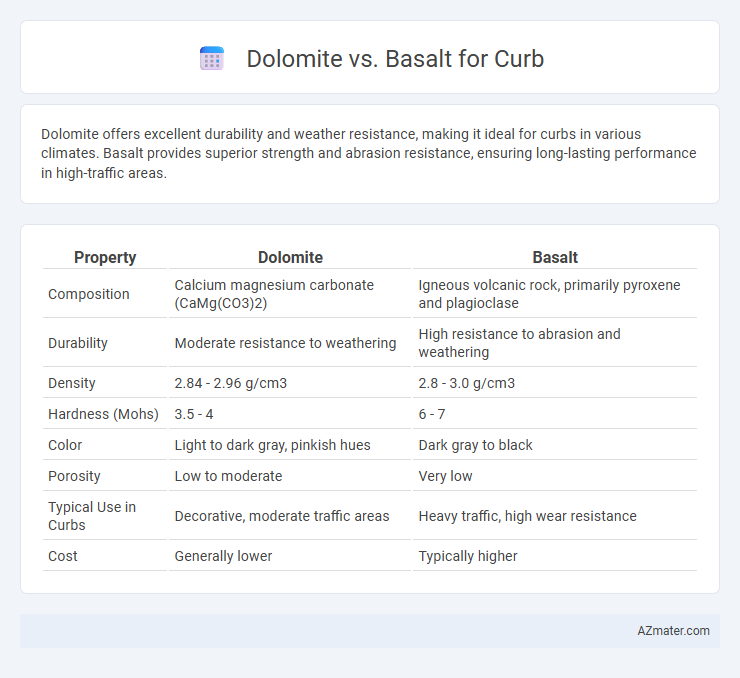Dolomite offers excellent durability and weather resistance, making it ideal for curbs in various climates. Basalt provides superior strength and abrasion resistance, ensuring long-lasting performance in high-traffic areas.
Table of Comparison
| Property | Dolomite | Basalt |
|---|---|---|
| Composition | Calcium magnesium carbonate (CaMg(CO3)2) | Igneous volcanic rock, primarily pyroxene and plagioclase |
| Durability | Moderate resistance to weathering | High resistance to abrasion and weathering |
| Density | 2.84 - 2.96 g/cm3 | 2.8 - 3.0 g/cm3 |
| Hardness (Mohs) | 3.5 - 4 | 6 - 7 |
| Color | Light to dark gray, pinkish hues | Dark gray to black |
| Porosity | Low to moderate | Very low |
| Typical Use in Curbs | Decorative, moderate traffic areas | Heavy traffic, high wear resistance |
| Cost | Generally lower | Typically higher |
Introduction: Dolomite vs Basalt for Curb Construction
Dolomite and basalt are key materials commonly used in curb construction due to their durability and strength. Dolomite offers high resistance to weathering and abrasion, making it suitable for areas with moderate traffic. Basalt, with its dense composition and superior compressive strength, is often preferred for curbs exposed to heavy loads and harsh environmental conditions.
Geological Origins of Dolomite and Basalt
Dolomite is a sedimentary carbonate rock primarily composed of the mineral dolomite, formed through the chemical alteration of limestone in marine environments during the Precambrian to Paleozoic eras. Basalt is an igneous extrusive rock formed from the rapid cooling of low-viscosity lava rich in iron and magnesium, originating from volcanic activity at tectonic plate boundaries. The distinct geological origins of dolomite and basalt influence their physical properties, making dolomite more porous and sedimentary in nature, while basalt is denser and fine-grained due to its volcanic origin.
Physical Properties Comparison: Strength and Durability
Dolomite exhibits high compressive strength and abrasion resistance, making it suitable for curb applications requiring durability against heavy traffic. Basalt surpasses dolomite with superior density and hardness, offering enhanced wear resistance and longevity in harsh environmental conditions. Both materials provide excellent strength, but basalt's durability under freeze-thaw cycles and chemical exposure generally makes it the preferred choice for long-lasting curbstones.
Workability and Cutting Ease
Dolomite offers moderate workability with a relatively smooth texture, making it easier to cut and shape for curb applications compared to basalt. Basalt, being a dense igneous rock with high compressive strength, presents greater challenges during cutting and requires specialized tools to achieve precise curb dimensions. The choice between dolomite and basalt for curbs heavily depends on balancing ease of fabrication against long-term durability and aesthetic preferences.
Weather Resistance and Longevity
Dolomite exhibits excellent weather resistance due to its high magnesium content, which enhances durability against freeze-thaw cycles, making it ideal for curb applications in variable climates. Basalt, a dense volcanic rock, offers superior longevity through its natural resistance to abrasion, chemical weathering, and moisture absorption, ensuring long-lasting curbs with minimal maintenance. Both materials withstand harsh environmental conditions, but basalt's low porosity grants it an edge in enduring heavy traffic and extreme weather over extended periods.
Visual Appeal: Color and Texture Differences
Dolomite curbs showcase a lighter color palette, ranging from white to light gray, with a fine-grained texture that offers a smooth and elegant appearance. Basalt curbs feature darker shades, typically deep gray to black, combined with a dense, coarse texture that provides a bold and rugged aesthetic. The contrast between Dolomite's bright, refined look and Basalt's strong, dramatic form highlights distinct visual appeal choices for urban and landscape design.
Cost Considerations and Availability
Dolomite tends to be more affordable than basalt for curbing due to its widespread availability and lower extraction costs. Basalt, while generally more expensive, offers greater durability and resistance to weathering, which can impact long-term maintenance expenses. Availability of dolomite is higher in regions with sedimentary rock deposits, whereas basalt is commonly sourced from volcanic areas, influencing local pricing and supply consistency.
Environmental Impact and Sustainability
Dolomite and basalt differ significantly in their environmental impact and sustainability when used for curbs. Dolomite mining can lead to habitat disruption and high carbon emissions due to extensive quarrying processes, whereas basalt is often considered more sustainable because it is abundant and has a lower carbon footprint during extraction. Additionally, basalt's durability reduces the need for frequent replacements, contributing to its long-term environmental benefits compared to dolomite.
Best Use Cases for Dolomite and Basalt Curbs
Dolomite curbs are ideal for urban environments requiring high durability and resistance to weathering, making them perfect for pedestrian walkways and parks where aesthetics and longevity matter. Basalt curbs excel in heavy-traffic areas and industrial zones due to their superior hardness and abrasion resistance, providing robust edge protection against vehicle impact. Both materials offer excellent strength, but the choice between dolomite and basalt depends on specific site conditions and load requirements.
Conclusion: Choosing the Right Stone for Your Curb
Dolomite offers durability and a lighter, more aesthetically versatile appearance, making it ideal for decorative curbs in residential landscapes. Basalt provides superior strength and weather resistance, suited for high-traffic or industrial curb installations. Selecting the right stone hinges on balancing visual appeal, environmental exposure, and load-bearing requirements to ensure longevity and performance.

Infographic: Dolomite vs Basalt for Curb
 azmater.com
azmater.com